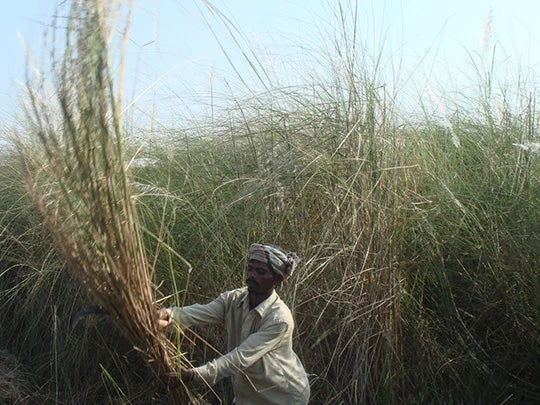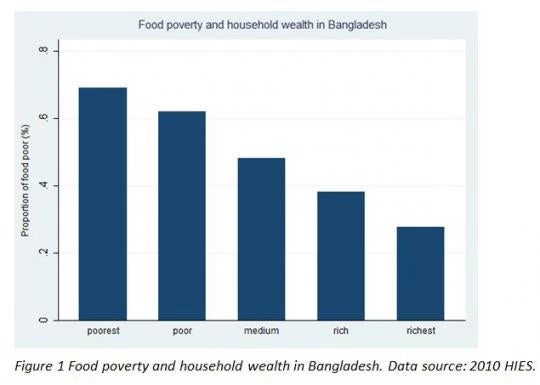Since gaining independence in 1971, food security issues in Bangladesh have been amongst the highest priorities on the government’s agenda. This is because Bangladesh faces a number of demographic, social and ecological challenges, which make it particularly vulnerable to food insecurity. These challenges are further exacerbated by climate change, including the consequences of sea level rise. Silent threats such as soil and river salinity and arsenic contamination have direct and indirect effects on agricultural production and households’ access to food.
In order to target the continuing food security threats the Government of Bangladesh has developed a number of high level policy initiatives, including Vision 2021 and the related Perspective Plan. Achieving food security is also a key objective of the country’s poverty reduction strategy and has been recognised to be the highest risk in the Bangladesh Climate Change Action Plan. Strategic objectives include realizing universal food security, which implies that the country needs to be not only self-sufficient in terms of food production but also manage equitable distribution of nutritious food. Ensuring universal food security is particularly challenging given the multidimensional nature of the food security concept which comprises food availability, physical and financial access to food, food utilisation and food stability.
In addition, the analysis of the Demographic and Health Survey (DHS) data reveals that food utilisation measured by nutritional outcomes remains a societal problem; approximately 41 per cent of children under five are stunted and 36 per cent are underweight. At the same time, 51 per cent of children suffer from anaemia. Importantly, overweight and obesity, while not official indicators of food security, show a worrying trend. The 2011 DHS report highlighted that almost 17 per cent of ever-married women aged 15-49 were overweight or obese, which constitutes an increase of around 8 percentage points from 2004. Finally, given both the economic and environmental vulnerability of the country, food stability remains a continuous challenge. After the cyclone Sidr food prices rose drastically throughout the country and a considerable proportion of households in disaster affected areas reported not having sufficient food stocks.
While Bangladesh is highly unlikely to achieve its ambitious 2021 universal food security goal, it should be recognised that progress has been made in a number of areas, as reflected by trends in nutritional and hunger indicators (although still alarmingly high). Key priorities for policy should include not only overall poverty reduction and ensuring food sufficiency but also focus on reducing economic inequalities and comprehensive disaster prevention strategies.
REFERENCES
ABEDIN, M. A., HABIBA, U. & SHAW, R. 2012. Impacts of Salinity, Arsenic, and Drought in Southwestern Bangladesh. In: SHAW, R. & TRAN, P. (eds.) Community, Environment and Disaster Risk Management Emerald Group Publishing
ATKINS, P., HASSAN, M. & DUNN, C. 2007. Poisons, pragmatic governance and deliberative democracy: The arsenic crisis in Bangladesh. Geoforum, 38, 155-170.
BCAS 2010. Scoping assessment on climate change adaptation in Bangladesh. Bangladesh Center for Advanced Studies (BCAS).
FAISAL, I. M. & PARVEEN, S. 2004. Food security in the face of climate change, population growth, and resource constraints: Implications for Bangladesh. Environmental Management, 34, 487-498.
FAO, IFAD & WFP 2013. The State of Food Insecurity in the World 2013. The multiple dimensions of food security. Rome: Food and Agriculture Organization of the United Nations (FAO), International Fund for Agricultural Development (IFAD) & World Food Programme (WFP).
GOLZAR, M. G., M., L.-N., S., A. S., REZA, A. H. M. S., C., Q., A.K.M.G., M. & N., Z. 2011. Arsenic Contamination of Groundwater of Kushtia Municipal Area, Kushtia District, Bangladesh International Journal of Earth Sciences and Engineering, 4, 807-818.
MEF 2009. Bangladesh Climate Change Action Plan and Strategy. Dhaka: Ministry of Environment and Forests (MEF).
MINISTRY OF AGRICULTURE & FAO 2011. Towards a Food Secure Bangladesh: Country Programming Framework 2010‐2015. Former National Medium Term Priority Framework. Dhaka: Ministry of Agriculture, Government of Peoples Republic of Bangladesh & Food and Agriculture Organization of the United Nations (FAO).
NICHOLLS, R. J. 2011. Planning for the Impacts of Sea Level Rise. Oceanography, 24, 144-157.
PLANNING COMMISSION 2011a. Perspective Plan of Bangladesh 2010-2021. Making Vision 2021 a Reality. General Economics Division. Planning Commission. Government of the People’s Republic of Bangladesh.
PLANNING COMMISSION 2011b. Sixth Five Year Plan FY2010-FY2015. Accelerating Growth and Reducing Poverty Planning Commission, Government of the People’s Republic of Bangladesh.
WFP 2007. Food Security Assessment. SIDR Cyclone – Bangladesh. World Food Programme (WFP).




Join the Conversation